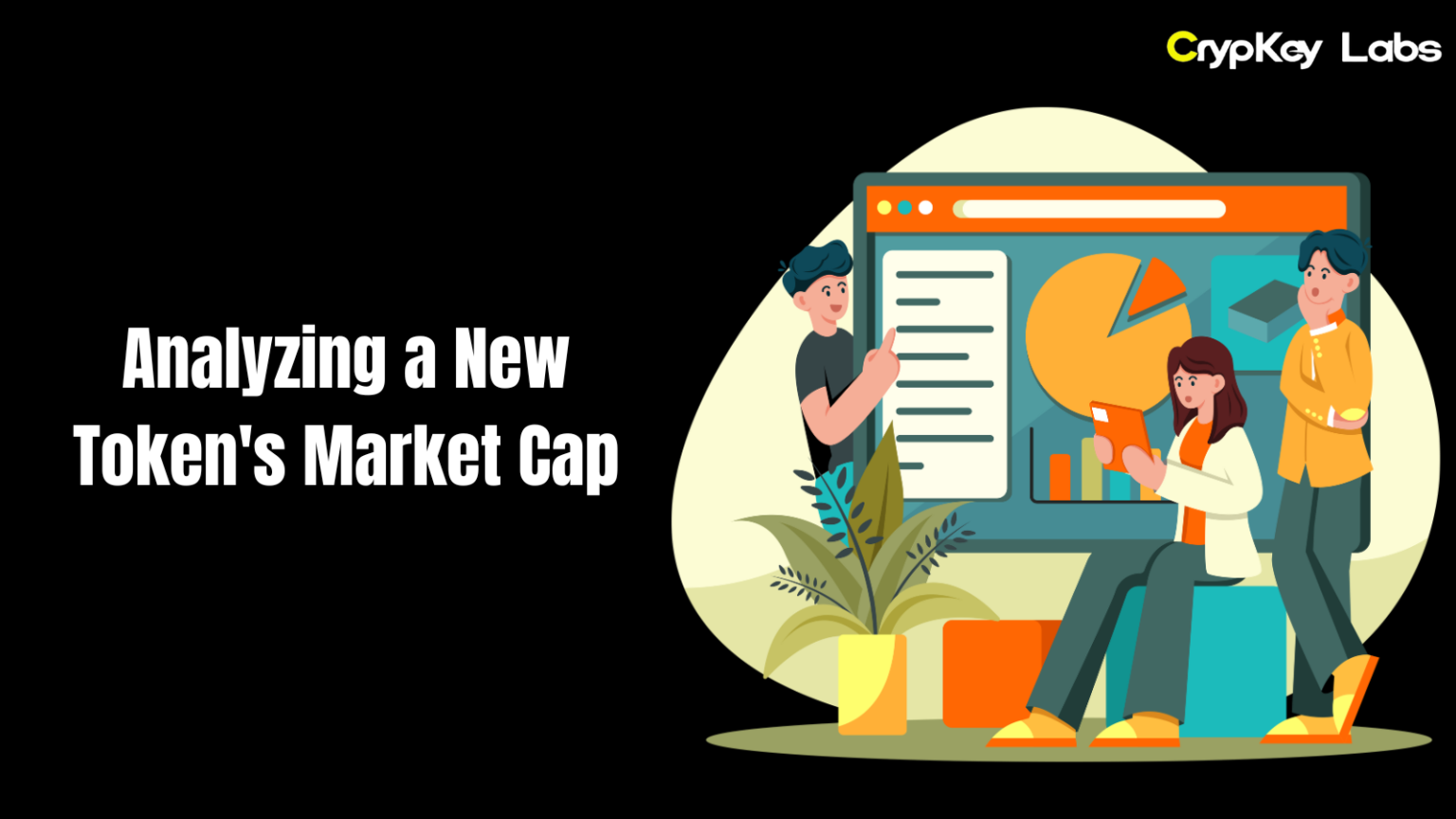Investing in cryptocurrency is exciting but also complex, especially when new tokens keep popping up. How do you know which tokens are worth your attention, and which might fizzle out? Market capitalization (or “market cap”) is one of the most common ways to measure a token’s value. By understanding a new token’s market cap, you’ll be better equipped to decide if it’s a good investment for you.
This guide will break down what market capitalization means in the crypto world and how to use it to analyze new tokens.
What is Market Capitalization in Cryptocurrency?
Market capitalization, or market cap, in cryptocurrency is simply a measure of a token’s total value in the market. It’s calculated with this formula:
Market Cap = Token Price × Circulating Supply
Unlike traditional stocks, where market cap often reflects the company’s total value, a crypto token’s market cap shows the perceived value based on the token price and supply.
Understanding this is critical because a token’s price alone doesn’t tell the whole story. A token could have a low price but a high supply, making its market cap high (and possibly indicating strong interest). Conversely, a high-priced token with a low supply could have a modest market cap, showing it might be less popular or have limited use.
Why Market Cap Matters
Why is market cap so important in crypto? It gives you a sense of the project’s size, stability, and growth potential. Here’s a breakdown of what the three general categories mean:
- Large Cap Tokens – Typically more established projects, like Bitcoin or Ethereum, with market caps in the billions. They’re often more stable but may offer lower growth potential.
- Mid Cap Tokens – Smaller projects with room to grow, often with market caps between $1 billion and $10 billion.
- Small Cap Tokens – Emerging tokens that might have high volatility and high growth potential. They can be very risky but are also where some investors find hidden gems.
Factors to Consider When Analyzing a New Token’s Market Cap
When evaluating a new token, there are a few key aspects of its market cap to examine.
Circulating Supply and Total Supply
Circulating supply refers to the number of tokens available on the market, while total supply includes all tokens, even those that aren’t yet available. A token with a high circulating supply might have a large market cap even at a low price. But if the circulating supply is set to increase rapidly, it could affect the token’s value over time.
Token Price Volatility
Crypto prices are famously volatile, which means market cap can change quickly. A token with a stable price and market cap might be less risky, while a highly volatile one may offer higher rewards (or losses). Track price trends to see how steady the token’s growth has been.
Tokenomics and Supply Mechanisms
Tokenomics refers to the economic model of the token, including how new tokens are introduced and how they’re distributed. For example, some tokens burn a portion of supply, reducing the number available, which can positively impact the token’s value. Others have vesting schedules, which means tokens are released over time to prevent sudden price drops.
Evaluating Market Cap Relative to Project Fundamentals
A token’s market cap alone doesn’t paint the full picture. To truly understand its potential, look at the fundamentals of the project behind the token.
Team and Development
Who’s behind the project? A team with experience in crypto and blockchain technology brings credibility and know-how. Research their past projects and achievements. If the team is anonymous, that might be a red flag, although some reputable projects have succeeded with anonymous teams.
Use Case and Utility
Why does this token exist? A token that solves real problems or offers unique utilities is more likely to succeed. Consider whether the token has a practical use beyond speculation. Tokens linked to decentralized finance (DeFi), gaming, or real-world assets often have clearer use cases and might attract a larger user base.
Community and Adoption Potential
Crypto communities can be powerful forces. Strong communities drive demand and spread awareness. Platforms like Reddit, Discord, and Twitter are great places to gauge a token’s community. Is the community active? Are they enthusiastic? A token with a large, engaged community may have better long-term prospects.
Partnerships and Integrations
Partnerships can boost a token’s credibility and adoption. For example, a DeFi token partnered with a popular exchange might attract more users. Check for any significant partnerships or integrations with other blockchain projects, which can indicate a promising future.
Comparing Market Cap with Competitors
To assess if a token is fairly valued, compare its market cap with similar projects. This can help identify overvalued or undervalued tokens.
For instance, if you’re looking at a DeFi token, check the market cap of other DeFi tokens with similar features. If your token’s market cap is significantly higher or lower, explore why. Perhaps it’s overhyped, or maybe it’s a hidden gem.
Several platforms, like CoinMarketCap and CoinGecko, provide tools to compare market caps across different tokens.
Long-Term Viability and Market Cap Projections
A token’s market cap growth potential depends on its roadmap, scalability, and ability to deliver on promises.
Growth Potential and Scalability
Look for projects with ambitious, realistic roadmaps. Check if they’re planning significant upgrades, feature launches, or partnerships. For example, a project that aims to support more users or integrate with other blockchains could have significant growth potential. Scalability, or the ability to handle a large number of users, is also crucial, especially for DeFi and gaming tokens.
Key Milestones and Future Goals
Has the project achieved any major goals yet? Tokens that hit their targets on time often inspire more investor confidence. Projects with clear milestones and a transparent path forward may have better chances of sustainable market cap growth.
Risk Assessment Based on Market Cap Size
A token’s market cap can also indicate its risk level. Here’s how to think about it:
- High Market Cap: Generally lower risk but might have slower growth. These tokens are less prone to price manipulation due to their established user base and liquidity.
- Low Market Cap: Higher risk but can be rewarding if successful. Small-cap tokens may experience sharp price swings and are sometimes subject to “pump and dump” schemes.
Before investing, consider your risk tolerance. Are you comfortable with the potential of losing part or all of your investment for a chance at higher returns?
Tools and Resources for Market Cap Analysis
Using the right tools can make market cap analysis easier. Here are a few popular options:
- CoinMarketCap: Offers detailed data on market caps, circulating supply, and price charts.
- CoinGecko: Similar to CoinMarketCap but with additional insights like developer activity and community stats.
- Token Terminal: For more in-depth analysis of a project’s financial metrics.
- DefiLlama: Useful for DeFi projects, providing data on total value locked (TVL) and other metrics.
These resources offer data to help you understand a token’s market cap in context. Be cautious, though – always cross-check information and look for up-to-date data.
Common Mistakes in Market Cap Analysis
Even experienced investors sometimes make these mistakes when analyzing market caps:
- Ignoring Circulating Supply: Focusing on token price without considering the supply can lead to skewed conclusions. Circulating supply affects market cap directly, so always check this number.
- Forgetting Project Fundamentals: A high market cap doesn’t guarantee project success. Understanding the project’s use case, team, and roadmap is key.
- Overrelying on Market Cap: Market cap alone isn’t enough. Use it in combination with other metrics, like trading volume and community engagement, for a well-rounded view.
Conclusion
Market cap analysis is a powerful tool, but it’s just one part of evaluating a new token. By understanding market cap alongside circulating supply, project fundamentals, community support, and long-term goals, you’ll be well-equipped to spot potential winners in the crypto space. Remember, the cryptocurrency market is volatile, so consider your risk tolerance and research thoroughly.
So, the next time you’re interested in a new token, don’t just glance at its price. Dive deeper into its market cap, understand its supply dynamics, and compare it to similar projects. The more informed you are, the better your investment decisions will be. Happy analyzing!







